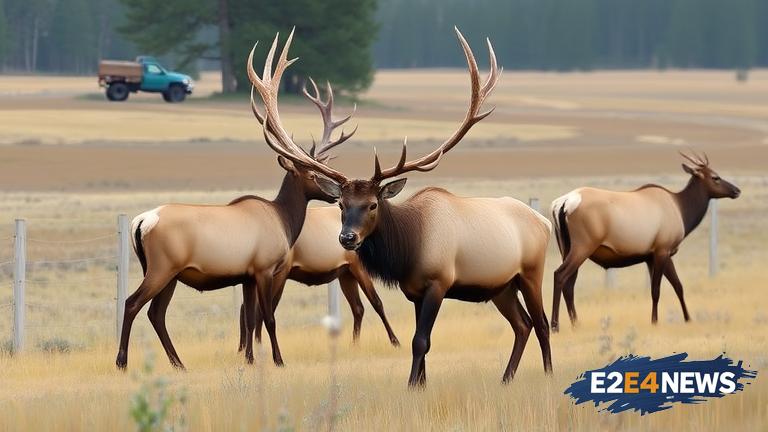The US Fish and Wildlife Service has given the green light to continue elk feeding in Wyoming’s Hoback Basin for another three years, sparking debate among wildlife experts and conservationists. The decision comes as the area is still reeling from a chronic wasting disease (CWD) epidemic that has affected the local elk population. CWD, a neurological disorder that affects deer, elk, and moose, has been a major concern in the region, with many calling for an end to the feeding program to prevent further spread of the disease. However, the Wyoming Game and Fish Department has argued that the feeding program is necessary to supplement the elk’s diet during harsh winter months. The program, which has been in place since the 1930s, provides feed to over 1,000 elk in the Hoback Basin area. Despite concerns over CWD, the US Fish and Wildlife Service has determined that the feeding program does not pose a significant threat to the environment. The agency has imposed certain conditions on the program, including increased monitoring and testing for CWD. The Wyoming Game and Fish Department has also implemented measures to reduce the risk of CWD transmission, such as removing elk that test positive for the disease from the feeding grounds. However, many experts remain skeptical about the effectiveness of these measures, citing the fact that CWD can remain in the environment for years after an infected animal has been removed. The decision to extend the feeding program has been met with criticism from some quarters, with many arguing that it prioritizes the interests of elk hunters and ranchers over those of wildlife conservation. Others have pointed out that the feeding program can actually do more harm than good, by artificially concentrating elk in a small area and increasing the risk of disease transmission. The CWD epidemic in the Hoback Basin has been particularly severe, with over 10% of the elk population testing positive for the disease. The disease has also been detected in other areas of Wyoming, including the Jackson Hole area. The Wyoming Game and Fish Department has implemented a number of measures to combat the spread of CWD, including increased testing and surveillance, as well as public education campaigns. However, the department has faced criticism for its handling of the epidemic, with some arguing that it has not done enough to address the issue. The extension of the elk feeding program has also raised concerns about the potential impact on other wildlife species in the area, including deer and moose. Some have argued that the feeding program could actually be contributing to the decline of these species, by altering the natural balance of the ecosystem. The US Fish and Wildlife Service has acknowledged these concerns, but has determined that the benefits of the feeding program outweigh the potential risks. The decision to extend the program is likely to be met with continued controversy and debate, as wildlife experts and conservationists weigh the pros and cons of the program. In the meantime, the Wyoming Game and Fish Department will continue to monitor the situation and implement measures to reduce the risk of CWD transmission. The department has also pledged to work with other agencies and stakeholders to develop a long-term plan for managing CWD in the state. As the situation continues to unfold, one thing is clear: the fate of Wyoming’s elk population, and the ecosystem as a whole, hangs in the balance. The decision to extend the elk feeding program has significant implications for the future of wildlife conservation in the state, and will likely be closely watched by experts and advocates in the years to come. The Wyoming Game and Fish Department has a difficult task ahead, as it seeks to balance the competing interests of elk hunters, ranchers, and conservationists, while also protecting the state’s valuable wildlife resources. The CWD epidemic has highlighted the need for a comprehensive and coordinated approach to managing wildlife disease, and the department will need to work closely with other agencies and stakeholders to develop effective strategies for addressing this issue. Ultimately, the success of these efforts will depend on a combination of science, policy, and public engagement, as well as a commitment to prioritizing the long-term health and sustainability of Wyoming’s wildlife populations.





